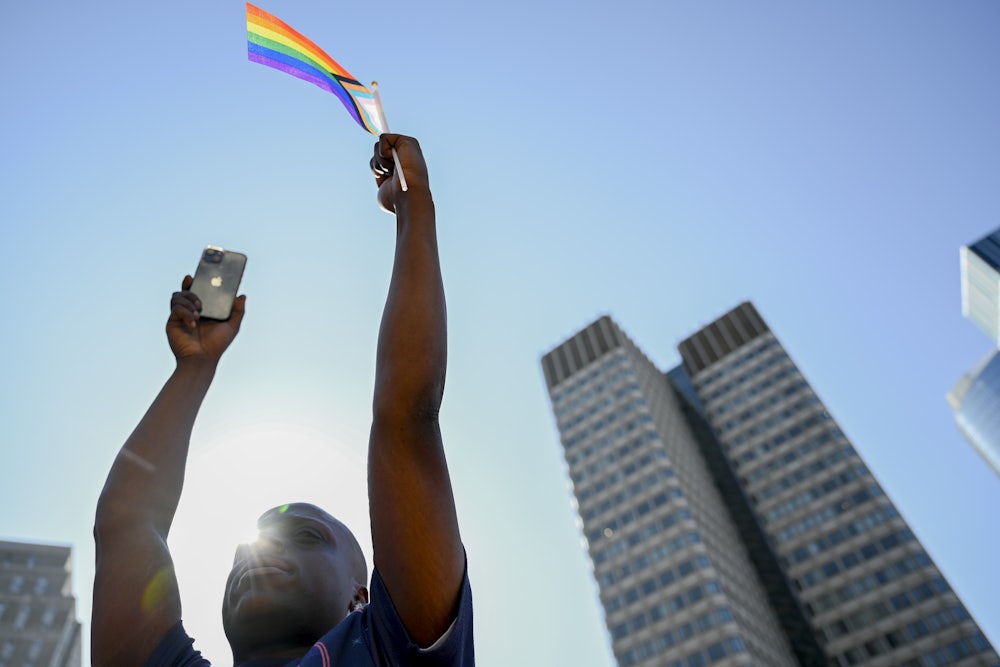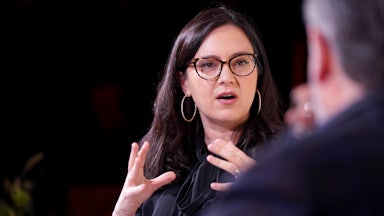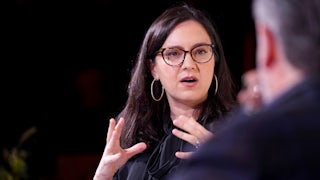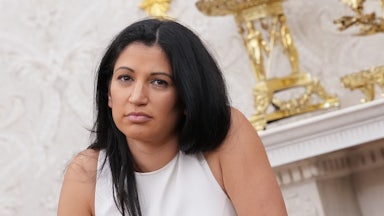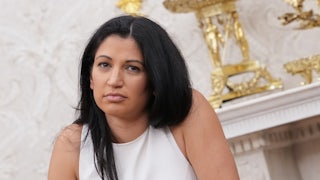On the morning of August 22, queer people awoke to the news that Autostraddle, the long-standing lesbian and queer digital publication, had been acquired by wellness and tech company For Them. For many readers, this sudden change in leadership was a shake-up, but the decision wasn’t quite as shocking for those on the media beat. Defector’s Lauren Theisen predicted as much last July, after charting the site’s recent layoffs, turbulent fundraising, and miraculous (if precarious) existence over the last 14 years. I too felt an acquisition was imminent—and if a deal couldn’t be made, I expected Autostraddle’s story to simply and unceremoniously end.
As far as the recent shifts in the landscape of queer media are concerned, this is pretty much par for the course. In 2017, the gay hookup app Grindr launched INTOmore, a catchall media hub for LGBTQ millennials that delivered some ambitious reporting and took home awards from both the National Association of LGBTQ+ Journalists, or NLGJA, and the Transgender Legal Defense and Education Fund.
But just 17 months later, the editorial team was suddenly let go and INTO sputtered out. (INTO relaunched in 2021 after an acquisition by Q Media, though the site lost much of its momentum in the confusing interregnum.) Then in 2019, the editor in chief of AfterEllen—a lesbian site that in recent years had made a sharp pivot to transphobia—announced the platform was effectively shutting down. That closure was followed by Bitch Media—which famously went from a stapled zine to a dynamic, independent media organization over the course of 25 storied years—ceasing operations in 2022. And naturally, print media in general has become even more vulnerable, as journals and publishers go under at semiregular intervals and larger, better funded papers seem to revel in calling their local gay counterparts “half-sunk old boats.”
There’s little doubt that queer media outlets were going to carry their share of the financial stresses that have engulfed the media industry as a whole. Even for more established, general outlets, media is more a wildfire than forest, with the once effervescently cool Vice Media now bankrupt (and still owing many writers, myself included, payment); the recent death knells of BuzzFeed News; and layoffs hitting legacy outlets such as Vox Media, NBC, and The Washington Post (just to name a few).
Between so many outlets going up in flames and a generation of burned-out writers caught in the blast, Autostraddle’s acquisition seemed like a glass of cold water. Some readers felt betrayed, regarding the acquisition as an ethically (though certainly not financially) bankrupt decision. But when the alternative is losing Autostraddle—or any queer media outlet—is independence really more important than survival?
The heat over the Autostraddle acquisition reminds me of a recent $10,000 grant awarded to Sinister Wisdom, a multicultural lesbian literary and art journal that has been publishing (and expanding) since 1976. (Full disclosure: I’ve been working with Sinister Wisdom, first as an intern and eventually on the board of directors, since 2016.) The grant was funded by the Amazon Literary Partnership and the Council of Literary Magazines and Publishers, or CLMP, and there’s been some anticipated pushback.
“Some women expressed concern about taking money from Amazon because of the history of Amazon, and the challenges that it brought to independent feminist bookstores,” says Sinister Wisdom editor and publisher Julie R. Enszer. “It is not too extreme to say that the advent of Amazon corresponded with the end of many independent feminist bookstores. Amazon was—and for many remains—an enemy to feminists and feminist books and ideas. I was aware of all of this when we applied for the grant—and when we accepted it.
“Operating an independent, lesbian-feminist journal means that everyday we make decisions about how we show up in the world and how we do our work,” says Enszer. “Did Sinister Wisdom ‘sell out’ by accepting a grant from Amazon Literary Partners? I know that lobbing that idea at Sinister Wisdom feels good to people making the accusation. [But] to remain a vital publisher, we need support for our work—and we need to expand support for our work. This grant will help us do that.”
All the same, there are undoubtedly some queer folks and lesbians who love the journal but will absolutely cancel their subscriptions over this grant. Part of this anger is tied to the cultural value many people put on independent and/or self-published queer media, zines, and publications, which have deep roots in gay and trans rights, social justice movements, and lesbian-feminist ethos.
“Print, through books, newspapers, and journals, and now through online media, is a way that lesbians and queer women find one another, network, and think together,” says Enszer, who is also a professor of gender, queer, and feminist studies, with a specialty in twentieth-century feminist literature. Zines were DIY pamphlets capturing everything from personal stories to vital resource networks to sites to odes of political activation. (During the AIDS epidemic, for example, when both the media and the state largely deserted the queer community, zines were there to fill the gaps, per the Queer Zine Archive Project.)
Then there were presses like Naiad Press, founded in 1973, and Kitchen Table: Woman of Color Press founded in 1980, both of which ushered in a prolific era of lesbian, feminist, and queer publishing. As a result, some specific values got valorized and deeply implanted among readers: a fierce independence, a suspicion of authority, and a politically rigorous, DIY attitude—all of which can foster a deep (and well-earned) distrust for corporate-owned or investor-sponsored media.
But unlike Sinister Wisdom’s situation, the frustrations with Autostraddle may go much deeper than just the acquisition. Back in 2019, a number of trans people and people of color shared public accounts of discomfort while attending A-Camp (Autostraddle’s summer camp spin-off entity). Soon after, leadership announced that A-Camp was taking a break, and it has not returned since. Then in March, Autostraddle asked the community to donate $175,000 to a life-sustaining fundraiser—stating that without the money, Autostraddle wouldn’t make it to Pride Month.
The community not only met the goal but exceeded it. But the money wasn’t enough to avoid layoffs, and three contract-based staff writers were let go in May, resulting in an open letter from staff writers and freelancers calling for increased financial transparency, accountability, and renewed commitments to marginalized—particularly Black and trans—readers and writers, among other concerns. Taken together, it’s clear that while Autostraddle has made some mistakes along the way, some readers’ reactions may be more about the culmination of hurts, rather than taking in the socioeconomic realities of media.
When I asked Reise Bernard, co-founder and former CEO of Autostraddle, what she thought about the acquisition naysayers, her response was measured: “We won’t get it right every time or even most of the time, but I hope they give us a chance to see what we can do with more resources and support because we’ve never had that chance before. We’re forming an incredible and diverse team of queer and trans people, and Kylo [Freeman] has investors on board who want to see us thrive. I think that’s great. I just hope they give us a chance.”
“Sometimes people in certain queer and trans echo chambers online see themselves as culture critics, so they feel justified in publicly criticizing the moves that other queer and trans people make without knowing all the facts,” says Daniela Capistrano, founder of POC Zine Project, editor in chief of TransLash Zine, and founder and CEO of DCAP Media. (Note: I was a 2023 news and narrative fellow for TransLash Media but did not work with Capistrano.) “Unfortunately, some of these folks don’t have enough knowledge of our own LGBTQ+ and civil rights history in the United States to be giving any kind of real critical feedback or nuanced analysis on these kinds of business decisions.
“Money alone doesn’t solve problems or free us,” Capistrano adds. “We help free each other, but ask any mutual aid or independent network … most of them are going to say they are very interested in receiving money in that way, and LGBTQ+ businesses have been quietly and publicly providing this support in our communities as both donors and investors in our communities for many decades.”
Capistrano believes the acquisition is “probably one of the best outcomes out of all possible options,” because Autostraddle is not only partnering with a values-aligned, queer and trans-led company, but the staff also maintains editorial control. “I am for LGBTQ+ folks planning strategically and cultivating abundance through interdependent collaboration; this can take the form of an independent LGBTQ+ platform collaborating with a values-aligned investor. But some folks often talk shit about what they don’t understand.”
At the same time, Capistrano doesn’t think Autostraddle is exempt from criticism from its community. They attended A-Camp in 2017 to lead a POC Zine Project workshop and recall valid grievances from trans attendees that year. “Since then they have done work to do better at centering trans voices and trans leadership by hiring more trans people,” says Capistrano. “But I do not personally interpret Autostraddle being acquired by an LGBTQ-led business to continue operating in a sustainable way as causing harm to anyone.”
Whether you like it or not, indie media doesn’t always mean better, more ethical, or even good. And sometimes queer people will make difficult decisions—be it accepting a grant or negotiating an acquisition—in exchange for the ability to do the work that matters.
You’d be hard-pressed to find a queer person—particularly those who aren’t cis queer men—who haven’t been personally impacted by Autostraddle. Early in my career, one of the first commissions I received was from an Autostraddle editor, ironically on the history of tatiana de la tierra, a devoutly independent lesbian publisher and zinester. Capistrano too wrote a piece for Autostraddle back in 2013. Even my wife, a nonwriter, found her way into Autostraddle through a 2017 Ken doll look-alike listicle. The site has a way of simply mattering to people.
Kylo Freeman, the new CEO of Autostraddle, has a similar story: “I honestly don’t remember how old I was exactly when I first read Autostraddle—very early on in university though. I was struggling with my sexuality. I was still with my boyfriend at the time,” they recall. “It was a combination of Autostraddle and The L Word, and Autostraddle’s reviews of The L Word that really opened my eyes to queer life and made me brave enough to start exploring it IRL.” More than anything, says Freeman, queer media is the only way for us to control how our experiences are told and communicated to the world.
And the recent months haven’t all been about endings or stressful changes There are new saplings taking root, right alongside sturdy sapphic oaks like Sinister Wisdom, Curve Magazine, and Autostraddle. Them, launched by Conde Nast in 2017, has earned the respect of many skeptics—and has gone on to champion political reporting and cultural analysis with a queer and trans lens. Queerency covers the queer economy and provides a database of hundreds of queer-owned businesses; TransLash Media, founded by journalist Imara Jones in 2018, is dedicated to trans stories for and by trans people.
In literary publishing, organizations like Lambda Literary, queer journals like Foglifter, and anthologies like Nepantla are certainly holding their own. And organizations like the NLGJA and the Trans Journalists Association are offering institutional support for new generations of journalists, publishers, and editors. If this media subculture has had to answer for its independence recently, it’s not had cause to question the vitality, or the resilience, of its core audience. In this way, queer media has distinguished itself from the all-things-to-all-people outlets that have endured similar disruptions or that scramble to woo its readership base.
“Queer media’s independence or survival?” Capistrano asks. “I have to push back and say I don’t think you have to choose … there have been multiple queer media outlets over the last several decades that have proven that it doesn’t have to be one or the other.”
Enszer too believes queer media is most vibrant in a diverse ecosystem. “We need both: independent queer media and queer perspectives in corporate media. And we need other structures of queer media in places where it is absent,” she says. “Independent queer media is important and vital and constantly needs people and money invested in its presence and its continued development and reimagining.”
The reality is, queer media is never going to be just one thing. But only a deeply invested base of readers worries about the possibility of an independent institution selling out. So while it may be hard to chart the future of these varied outlets, all these rampant passions are perhaps the best evidence that there will be space enough for all: independent, for-profit, local and national papers, presses, zines, publications, blogs, and yes, Autostraddle too.
